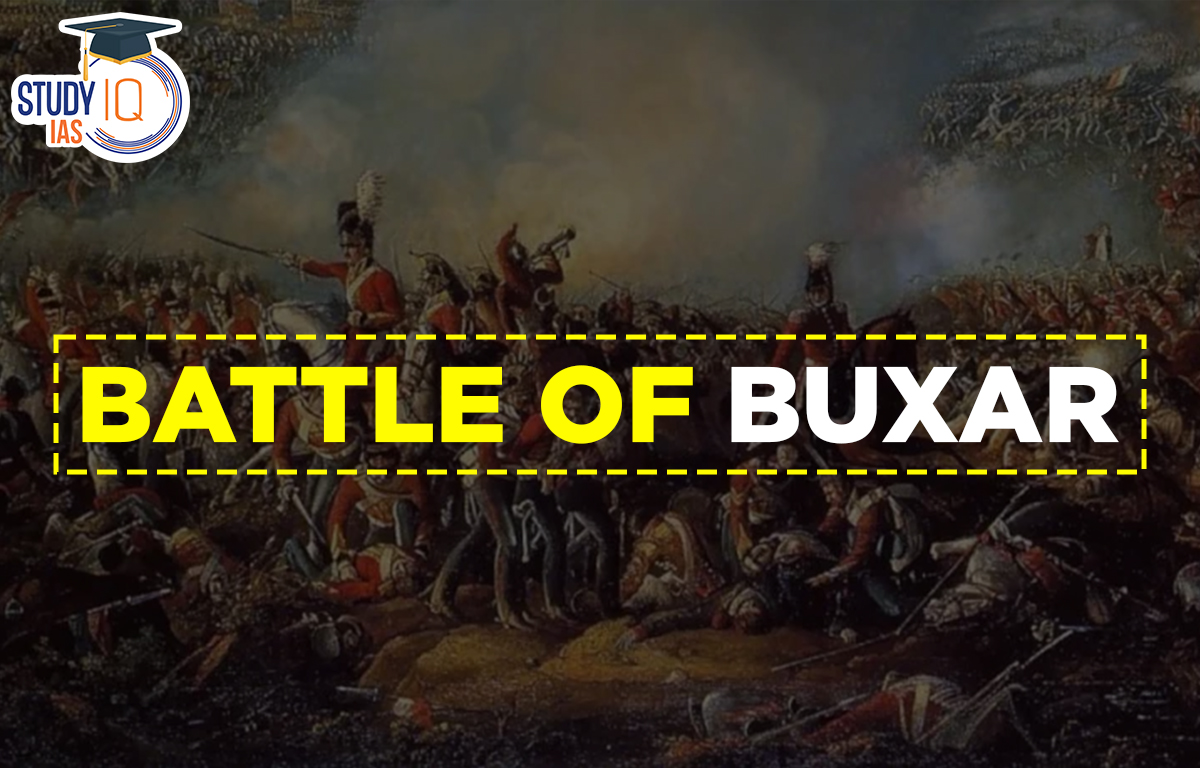Table of Contents
Battle of Buxar
The Battle of Buxar was one of the pivotal conflicts in India’s history and its lengthy alliance with British Colonial forces. British hegemony over the local kingdoms in the Indian subcontinent was successfully established during the Battle of Buxar 1764 War.
On October 22, 1764, the Battle of Buxar took place at Buxar, Bihar as it is known today. The combined armies of Bengal’s Nawab Mir Qasim, Awadh’s Nawab Shuja-ud-Daula, and Mughal Emperor Shah Alam II fought the East India Company in the Buxar War. To put a stop to the conflict, the Treaty of Allahabad was signed in 1765.
The Mughal emperor’s combined armies, the Nawabs of Bengal and Oudh, and the English forces engaged in combat at the Battle of Buxar. If one were to look back at the causes of the fight, one would find some historical context. The British took advantage of the commercial privileges that were granted to them, mostly due to their imperial and colonial ambitions toward the territorial, economic, and political conquest of India.
Battle of Buxar Background
1. Mughal Period
Bengal has been a province with significant weight and importance ever since the Mughal era. The province was among the most fertile. And it was really affluent. Bihar, Orissa, and the modern-day nation of Bangladesh were all part of Mughal Bengal. The Bengali Nawab held all of the reins of power.
2. Economic Importance
The silk, saltpetre, and world-class textiles produced in Bengal’s province were of enormous economic importance and significance. Saltpetre, indigo, rice, silk, cotton, handicrafts, and other goods are regularly shipped from Bengal to Europe. Almost 60% of British imports from Asia were made up of Bengali products.
3. British Period
Bengal served as the British colonial powers’ stepping stone. It was the first kingdom that British forces had taken control over. Here, the East India Company set up a successful trading system. The British were able to dominate India thanks to Bengal’s vast riches and resources. The British East India Company built Calcutta’s modern-day British commercial settlement’s basis during the 1690s. The Mughal Emperor received an annual payment of Rs 3,000 (about £ 350) from the EIC in exchange for allowing their operations in Bengal.
4. Conflicts between Nawabs and the British
Under the Mughal Empire, the British enjoyed unique privileges, which the Nawabs of Bengal disliked since it diminished their provincial rights. Commercial considerations were the driving force behind the conflict between the Nawabs and the British. The British saw that the nawabs’ continued reliance on direct control over the provinces blinded them to the emergence of indirect but supreme authority in their hands.
Battle of Buxar Causes
The Battle of Plassey, which enabled the British to establish them in the Bengal region, was followed by the Battle of Buxar. The Nawab of Bengal and his French allies engaged the British army in the Battle of Plassey in June 1757. As a result of this conflict, Siraj-Ud-Daulah was removed from his position as Bengal’s Nawab. Mir Jafar took his place.
Mir Jafar was chosen to serve as the EIC’s puppet. But his son-in-law Mir Qasim took his place when he joined the Dutch East India Company. When Mir Jafar left his position in favour of Qasim, a pension of Rs 1,500 was approved.
When Mir Qasim moved his capital from Calcutta to Munger Fort, he was motivated by self-serving objectives. He began assembling an army by bringing in foreign instructors, some of whom were at war with the British. The English traders received no preferential treatment. He saw both British and Indian traders as sharing the same space.
He was not the puppet that the English had expected when they appointed him; therefore they decided to remove him. He made it challenging for the British to exercise indirect authority and gain from a region like Bengal. In 1763, there was a conflict between Qasim and the British.
Being a sovereign independent from British influence and indirect control allowed Qasim to streamline his government. The British EIC’s mistreatment and abuse of Dastak and Farman did not sit well with him. He also made efforts to cut back on spending on administrative and palace operations, which rankled the British.
Shuja-ud-Daulah, the Nawab of Oudh, and Shah Alam II of the Mughal Empire were not pleased with the EIC’s expansion into the province of Bengal and their consequent abuse of trade freedoms, which was harming their business. As a result, their soldiers joined forces with Qasim for their mutual interests and gain.
The British sought special treatment that would elevate their industry above that of rivals. Mir Qasim, who treated the British merchants like the Indian merchants, did not offer this. This led to the British beginning to suffer significant losses. This necessitated the conquest of Bengal.
Battle of Buxar Course of War
1. Year 1763
British East India Company and Mir Qasim’s men engaged in combat. While the English won in Katwah, Murshidabad, Giria, Sooty, and Munger, Mir Qasim suffered severely. As a result, Mir Qasim had to leave Awadh (or Oudh). He established a confederacy with Shah Alam II and Shuja-Ud-Daulah (the Nawab of Awadh) in order to retake Bengal (Mughal Emperor).
2. Year 1764
In 1764, the Mughals, the Nawab of Awadh, and Mir Qasim fought alongside the British Forces. Major Munro oversaw the British side while Mir Qasim headed the Indian side. The 40,000-man Mughal, Awadh, and Mir Qasim united force was ruthlessly crushed by the 10,000-man British Army. The fight was lost by the Indian side on October 22, 1764. The other two submitted to the English forces while Mir Qasim fled the conflict.
3. 1765
In 1765, the British compelled the Nawab of Oudh and the Mughal Emperor to sign the humiliating Treaty of Allahabad.
Battle of Buxar Was Fought Between
The Buxar Battle participants and their role in the conflict are described in the table below:
| Participants | Role |
| Mir Qasim | He disliked how the English were misusing dastak and farmland, which led him to plot against them. formed a coalition for the Buxar War with the Nawab of Awadh and the Mughal Emperor Shah Alam II. |
| Shuja-Ud-Daulah (Nawab of Awadh/Oudh) | He was a member of a confederacy with Shah Alam-II and Mir Qasim. |
| Shah Alam II (Mughal Emperor) | He desired to expel the English from Bengal. |
| Hector Munro | He was in charge of the English army during the Battle of Buxar |
| Robert Clive | After triumphing in the Battle of Buxar, he signed the treaties with Shuja-Ud-Daulah and Shah Alam II |
Battle of Buxar Significance
Through the Battle of Buxar, colonial dominance over the province of Bengal was formally established. The Nawab had been vanquished and replaced by the EIC’s army. The British now controlled the entire province, which included the modern states of Bihar and Orissa as well as Bangladesh. Even though Mir Qasim fled with vast wealth, Munro’s forces beat the confederacy’s soldiers, and the fugitive Mir Qasim perished in obscurity and poverty.
The Nawab of Bengal’s independence had been put an end by the Battle of Plassey in 1757. However, the British forces also exerted political dominance and control over the Awadh and the Mughal Empire during the Battle of Buxar. The British gained a solid foundation in India thanks to the Battle of Buxar, which eventually allowed them to dominate the entire country.
Battle of Buxar Impact
On October 22, 1764, the British forces routed the alliance that Shah Alam II, Shuja-Ud-Daula, and Mir Qasim had formed. Robert Clive played a significant role in the victory that Major Hector Munro oversaw for the British troops. With control over the Mughal domain and the province of Awadh following the Buxar conflict, the English rose to prominence in the North.
Mir Qasim gave the English control over the Midnapore, Burdwan, and Chittagong districts in order to support the army. Duty-free trade permits were issued to English traders following the Battle of Buxar in 1764. Only salt was still subject to a 2% tariff.
Najimud-Daula, Mir Jafar’s younger son, assumed the throne after his death. But since the English held control over both the military and the government, this was only an acknowledgment to the situation. Shuja-Ud-Daula of Awadh and Shah Alam II had their differences resolved by the Treaty of Allahabad. This was led by Robert Clive.
Battle of Buxar UPSC
On October 22, 1764, the British army under Hector Munro engaged an alliance of Indian kings from Bengal, Awadh, and the Mughal Empire at the Battle of Buxar. This pivotal conflict paved the way for the British to dominate India for the following 183 years. After winning the Battle of Plassey in 1757, the British East India Company turned its attention to Bengal. The Mughal Emperor submitted and Bengal was taken over by the British in 1765, marking the end of the conflict. We will gain in-depth information about the causes and significance of the Battle of Buxar in this post, which will be beneficial for UPSC exam preparation.


 Maharashtra’s Mendrachi Vancharai Syst...
Maharashtra’s Mendrachi Vancharai Syst...
 Keeladi Excavation: Uncovering the Ancie...
Keeladi Excavation: Uncovering the Ancie...
 Sanyasi Revolt, Objectives, History, Rea...
Sanyasi Revolt, Objectives, History, Rea...





















